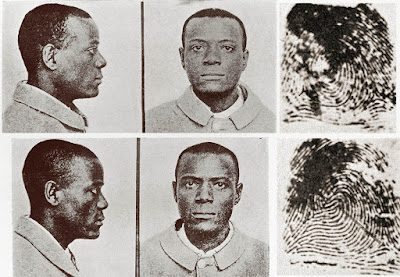In 1903 when Will West, convicted of a crime, was delivered to Leavenworth Penitentiary to serve his sentence, the records clerk M.W. McClaughry informed him he was already in Leavenworth, serving time for murder. It turned out that a person of practically identical name, appearance and Bertillon measurements was already in the prison system.
The Bertillon system for identification, developed by French anthropologist Alphonse Bertillon in the 1880s, involved taking precise physical measurements of a person’s head and body, which were included on a card along with photos and a description of identifying personal features.
A chronology of the West’s
case shows that the records clerk learned of the fingerprint identification system
from Sgt. John K. Ferrier of Scotland Yard in 1904 at the St. Louis World’s
Fair. In September of that year, Major R.W. McClaughry, warden at the penitentiary,
requested permission to install the fingerprint system at Leavenworth. In
November that permission was granted. Will and William West's unique fingerprints were
finally captured and compared in 1905.
The Will/William West
case has been credited with ushering in the use of fingerprints for identifying
inmates by law enforcement. In truth, the case was not well known until after the
fingerprint identification was already established in the U.S. (It was adopted
by the U.S. Military in 1905, and quickly thereafter adopted by police agencies.)
The case was not reported in print until 1918 in an article “Personal Identification” by Harris Wilder and Bert Wentworth. However, the West case is an interesting story, and does help to illustrate the reason why fingerprinting replaced the Bertillon system.
Today, fingerprinting remains critical for identification in the criminal justice system, useful for identifying records and maintaining criminal history.
The case was not reported in print until 1918 in an article “Personal Identification” by Harris Wilder and Bert Wentworth. However, the West case is an interesting story, and does help to illustrate the reason why fingerprinting replaced the Bertillon system.
Today, fingerprinting remains critical for identification in the criminal justice system, useful for identifying records and maintaining criminal history.
Will and William West conundrum: How two unrelated but identical inmates showed need for fingerprinting
by Martin Chalakoski, Sept. 29, 2017, for thevintagenews.com
A Fingerprint Fable: The Will and William West Case
by Robert D. Olsen, Sr., Kansas Bureau of Investigation
(This story appeared in the November 1987, Vol. 37, No. 11 issue of Identification News, which was the next to the last issue prior to changing publication format and becoming the Journal of Forensic Identification)
History of Fingerprints
2018, Crime Scene Forensics, LLC, Concord, NC; www.crimescene-forensics.com
Accurate Biometrics
Managed Fingerprinting and Identity Solutions

No comments:
Post a Comment